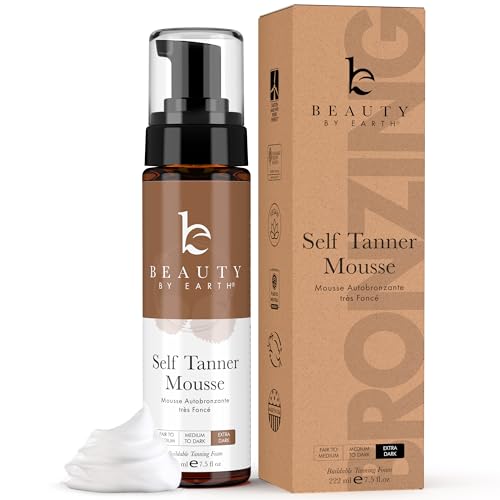
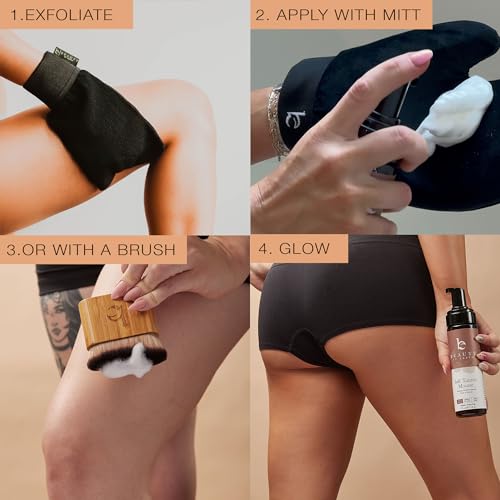
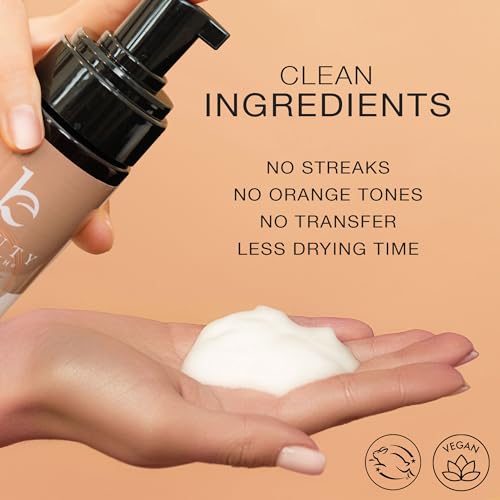

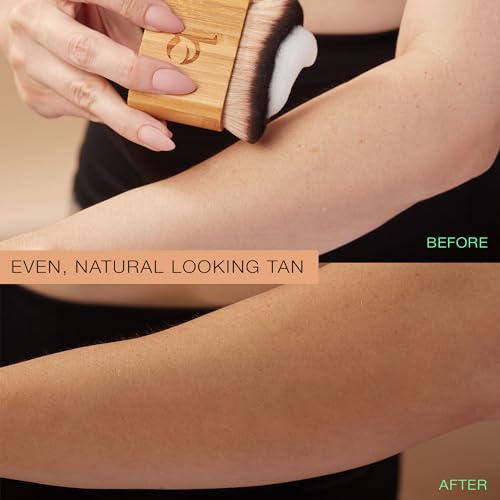
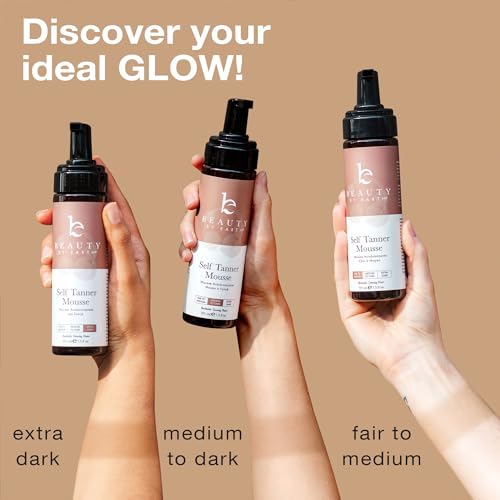
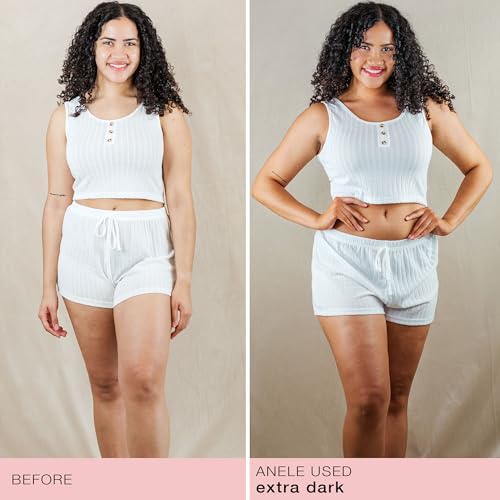
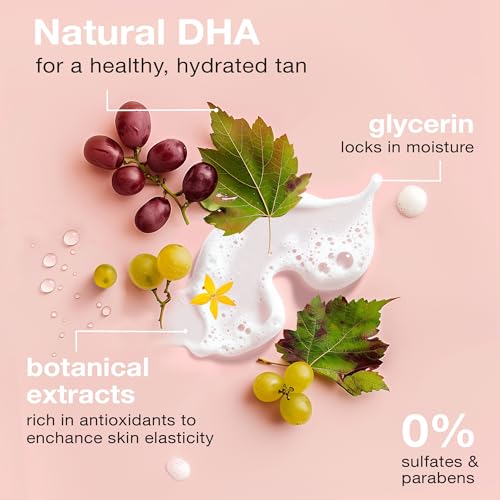
Beauty by Earth Self Tanner Mousse - Natural Dark Tan, Vegan & Cruelty-Free - 7oz


Pinus Strobus (White Pine) Bark Extract
High RiskPinus strobus (white pine) bark extract is derived from the bark of the white pine tree. It is commonly used in cosmetic and personal care products for its potential antioxidant properties and as a natural source of compounds that may benefit skin health.
Sustai Insights
Pinus strobus bark extract offers functional benefits such as antioxidant properties, which may enhance skin health. However, it is associated with high regulatory restrictions, indicating potential safety concerns. Health risks appear low for carcinogenicity, allergies, and reproductive toxicity, but environmental risks remain a consideration. The ingredient's overall risk level is assessed as high, necessitating careful usage practices and consideration of alternative ingredients.
Linalool
High RiskLinalool is a terpene commonly found in various plants, particularly in lavender and mint. It is primarily used in products for its fragrance and potential antimicrobial properties. Linalool is also utilized in formulations for its ability to enhance the sensory experience of personal care and household products.
Sustai Insights
Linalool offers functional benefits as a naturally occurring fragrance component and may exhibit antimicrobial properties. However, it presents high allergenic potential, with concerns about skin irritation and sensitization. Environmental risks include contamination issues, though it is not classified as a persistent pollutant. Regulatory bodies have noted the need for careful handling due to its allergenic nature. Overall, despite some beneficial attributes, the ingredient carries a high risk profile, warranting cautious use and consideration of safer alternatives.
Farnesol
High RiskFarnesol is a flavor and perfume ingredient found in various cosmetic and personal care products. It is primarily used for its scent and potential antimicrobial properties, contributing to the overall fragrance profile of formulations.
Sustai Insights
Farnesol offers functional benefits as a fragrance component, but it raises significant health concerns, particularly its high allergenic potential. Regulatory bodies have imposed restrictions on its usage due to these risks. Environmentally, it poses risks as a potential pollutant, though it is not classified as bioaccumulative. Overall, the risk level associated with farnesol is high, necessitating careful consideration in product formulation and use. Alternatives such as natural essential oils may provide safer options.
Dihydroxyacetone
High RiskDihydroxyacetone is an aliphatic ketone commonly used as a color additive in cosmetics, particularly in self-tanning products. It reacts with amino acids in the skin to produce a temporary brown color, mimicking a tan without exposure to UV radiation.
Sustai Insights
Dihydroxyacetone offers functional benefits as a skin-tanning agent without UV exposure, making it a safer alternative for achieving a bronzed appearance. However, it carries high use restrictions and is associated with low health risks such as irritation. Environmental concerns include its potential to contribute to pollution, while regulatory bodies may issue warnings regarding its use. Overall, the ingredient presents a high risk, necessitating careful consideration of usage practices and potential alternatives.
Rosmarinus Officinalis (Rosemary) Leaf Extract
Medium RiskRosemary leaf extract is produced from the leaves of the Rosmarinus officinalis plant. It is commonly used in cosmetic formulations for its potential antioxidant properties and fragrance. The extract may also contribute to the preservation of products due to its antimicrobial characteristics.
Sustai Insights
Rosemary leaf extract offers functional benefits such as antioxidant and antimicrobial properties, which can enhance product stability and shelf-life. It is generally considered low risk for carcinogenicity and reproductive toxicity, but it carries a moderate potential for allergic reactions. Environmentally, it poses low risk with no significant pollutant or bioaccumulation concerns. Regulatory bodies have not placed significant restrictions on its use, although some verified products cannot contain certain concentrations. Overall, the ingredient's risk level is medium, necessitating careful usage practices to mitigate allergic responses.
Glycyrrhiza Glabra (Licorice) Root Extract
Medium RiskGlycyrrhiza glabra (licorice) root extract is derived from the root of the licorice plant and is commonly used in cosmetic formulations for its soothing properties. It is known for its ability to impart a sweet flavor and is utilized for its skin-brightening and anti-inflammatory effects.
Sustai Insights
Licorice root extract offers functional benefits such as skin soothing and anti-inflammatory properties, making it valuable in cosmetic formulations. It is sourced sustainably; however, it poses low to moderate health risks, including potential allergenic effects and endocrine disruption. Environmental concerns are minimal, with no significant pollutant or bioaccumulation potential. Regulatory bodies restrict its use in certain concentrations, leading to a moderate overall risk assessment. Safe usage practices should be adhered to, and alternatives like chamomile extract may be considered for those seeking lower risk options.
Vitis Vinifera (Grape) Seed Extract
Low RiskVitis vinifera (grape) seed extract is derived from the seeds of grapes and is commonly used in cosmetic formulations for its antioxidant properties. It functions primarily as a skin-conditioning agent and is known for its potential benefits in skincare products.
Sustai Insights
Grape seed extract is valued for its antioxidant properties, which can help protect the skin from oxidative stress. It is generally regarded as safe with low concerns regarding carcinogenicity, allergies, and reproductive toxicity. Environmentally, it poses minimal risks and is not known to bioaccumulate. Regulatory bodies do not impose significant restrictions on its use. Overall, it is assessed as low risk, making it a suitable choice in cosmetic formulations. Alternatives include other plant extracts with similar benefits, such as green tea extract.
Panthenol, D
Low RiskPanthenol, also known as provitamin B5, is a humectant commonly used in cosmetic and personal care products. It functions primarily as a moisturizer, enhancing skin hydration and improving the appearance of hair by imparting shine and softness.
Sustai Insights
Panthenol is effective in retaining moisture, thus providing functional benefits for skin and hair care products. It is generally recognized as safe, with low concerns regarding carcinogenicity, allergies, and developmental toxicity. However, potential cumulative exposure from multiple sources exists. Environmental risks are minimal, and it is not bioaccumulative. Regulatory bodies have not issued significant warnings; therefore, the overall risk level is assessed as low. For optimal use, it is recommended to follow product guidelines, and alternatives such as glycerin may also be considered for moisturizing effects.
Chamomilla Recutita (Matricaria) Flower Extract
Low RiskChamomilla recutita (Matricaria) flower extract is derived from the flower of the chamomile plant. It is commonly used in cosmetic products for its soothing properties and as an anti-inflammatory agent. This extract is valued for its potential to calm skin irritations and enhance overall skin appearance.
Sustai Insights
Chamomilla recutita (Matricaria) flower extract is recognized for its soothing and anti-inflammatory benefits, making it effective in skincare formulations. It is sustainably sourced and not associated with significant health risks, such as carcinogenicity or allergenic potential, resulting in a low-risk profile. Environmental concerns are minimal as it does not contribute significantly to pollution. Regulatory bodies impose few restrictions on its use, further supporting its safety. However, users should practice standard safety measures, particularly if they have known sensitivities. Overall, it is a low-risk ingredient with favorable attributes.
Sodium Acetylhyaluronate
Low RiskSodium acetylhyaluronate is a sodium salt derivative of hyaluronic acid, commonly used in cosmetic formulations for its hydrating properties. It functions primarily as a humectant, attracting moisture to the skin and helping to maintain hydration levels in various personal care products.
Sustai Insights
Sodium acetylhyaluronate is recognized for its effective moisture-retaining properties, enhancing skin hydration and improving product texture. It has low health risks, with negligible concerns regarding carcinogenicity, allergies, or reproductive toxicity. Environmentally, it poses minimal risks and is not associated with significant pollution or bioaccumulation. Regulatory assessments indicate no current restrictions. Overall, it is considered low risk, making it a favorable ingredient in cosmetic formulations.
Decyl Glucoside
Low RiskDecyl glucoside is a glucose-based surfactant derived from natural sources, primarily used as a mild cleansing agent in personal care products. It effectively reduces surface tension, allowing for improved mixing of ingredients and enhanced cleansing properties without stripping natural oils from the skin.
Sustai Insights
Decyl glucoside offers functional benefits as a non-ionic surfactant, making it suitable for sensitive skin formulations. It is biodegradable and derived from renewable resources, supporting sustainability. Health risks are primarily low, with minimal concerns regarding irritation and allergies. Environmental risks are low, as it does not significantly contribute to pollution or bioaccumulation. Regulatory status is generally favorable, with low restrictions noted. Overall, decyl glucoside presents a low risk for use in consumer products, making it a suitable choice for gentle formulations.
Vegetarian Glycerin
Low RiskVegetarian glycerin, also known as glycerol, is a colorless, odorless, and viscous liquid derived from plant sources. It is primarily used as a humectant, solvent, and emollient in various personal care products, helping to retain moisture and improve texture.
Sustai Insights
Vegetarian glycerin offers functional benefits as an effective humectant, promoting hydration and skin smoothness. It is biodegradable and typically sustainably sourced. Health risks associated with glycerin are low, with no significant concerns for carcinogenicity, allergens, or reproductive toxicity. Environmental risks are minimal, and it is not subject to major regulatory warnings. Overall, the risk level for this ingredient is low, making it a safe choice in formulations. Safe usage practices include ensuring proper concentrations in products, and alternatives such as propylene glycol exist but may have differing properties.
Hamamelis Virginiana (Witch Hazel) Distillate
Low RiskHamamelis virginiana (witch hazel) distillate is a plant-derived extract commonly used in cosmetic formulations for its astringent and soothing properties. It is primarily utilized for its ability to reduce inflammation and tighten skin, making it a popular ingredient in toners and aftershaves.
Sustai Insights
Witch hazel distillate exhibits several functional benefits, including its anti-inflammatory and astringent properties, which are beneficial for skin care. It is considered to have low health risks regarding carcinogenicity, allergies, and reproductive toxicity, with enhanced skin absorption being noted. Environmental concerns are minimal, as it is not classified as a pollutant or bioaccumulative. Regulatory bodies do not impose significant restrictions on its use. Overall, it is assessed as low risk, with recommendations for safe application in cosmetic products and consideration of alternatives like chamomile extract for similar benefits.
Cocamidopropylamine Oxide
Low RiskCocamidopropylamine oxide is a tertiary amine derived from coconut oil, commonly used as a surfactant and foam booster in cosmetic and personal care products. It helps enhance the cleansing properties of formulations and improves the texture of products such as shampoos and body washes.
Sustai Insights
Cocamidopropylamine oxide offers functional benefits as an effective surfactant, enhancing product performance while being derived from renewable coconut sources, which supports sustainability. Health risks are minimal, with low concerns regarding carcinogenicity, allergies, or reproductive toxicity. Environmental risks are also low, with no significant pollutant potential noted. Regulatory assessments indicate no severe restrictions. Overall, this ingredient is considered low risk, promoting safe use in personal care formulations.
Vitis Vinifera (Grape) Seed Extract
Low RiskVitis vinifera (grape) seed extract is derived from the seeds of grapes and is commonly used in cosmetic formulations for its antioxidant properties. It functions primarily as a skin-conditioning agent and is known for its potential benefits in skincare products.
Sustai Insights
Grape seed extract is valued for its antioxidant properties, which can help protect the skin from oxidative stress. It is generally regarded as safe with low concerns regarding carcinogenicity, allergies, and reproductive toxicity. Environmentally, it poses minimal risks and is not known to bioaccumulate. Regulatory bodies do not impose significant restrictions on its use. Overall, it is assessed as low risk, making it a suitable choice in cosmetic formulations. Alternatives include other plant extracts with similar benefits, such as green tea extract.
Panthenol, D
Low RiskPanthenol, also known as provitamin B5, is a humectant commonly used in cosmetic and personal care products. It functions primarily as a moisturizer, enhancing skin hydration and improving the appearance of hair by imparting shine and softness.
Sustai Insights
Panthenol is effective in retaining moisture, thus providing functional benefits for skin and hair care products. It is generally recognized as safe, with low concerns regarding carcinogenicity, allergies, and developmental toxicity. However, potential cumulative exposure from multiple sources exists. Environmental risks are minimal, and it is not bioaccumulative. Regulatory bodies have not issued significant warnings; therefore, the overall risk level is assessed as low. For optimal use, it is recommended to follow product guidelines, and alternatives such as glycerin may also be considered for moisturizing effects.
Pinus Strobus (White Pine) Bark Extract
High RiskPinus strobus (white pine) bark extract is derived from the bark of the white pine tree. It is commonly used in cosmetic and personal care products for its potential antioxidant properties and as a natural source of compounds that may benefit skin health.
Sustai Insights
Pinus strobus bark extract offers functional benefits such as antioxidant properties, which may enhance skin health. However, it is associated with high regulatory restrictions, indicating potential safety concerns. Health risks appear low for carcinogenicity, allergies, and reproductive toxicity, but environmental risks remain a consideration. The ingredient's overall risk level is assessed as high, necessitating careful usage practices and consideration of alternative ingredients.
Rosmarinus Officinalis (Rosemary) Leaf Extract
Medium RiskRosemary leaf extract is produced from the leaves of the Rosmarinus officinalis plant. It is commonly used in cosmetic formulations for its potential antioxidant properties and fragrance. The extract may also contribute to the preservation of products due to its antimicrobial characteristics.
Sustai Insights
Rosemary leaf extract offers functional benefits such as antioxidant and antimicrobial properties, which can enhance product stability and shelf-life. It is generally considered low risk for carcinogenicity and reproductive toxicity, but it carries a moderate potential for allergic reactions. Environmentally, it poses low risk with no significant pollutant or bioaccumulation concerns. Regulatory bodies have not placed significant restrictions on its use, although some verified products cannot contain certain concentrations. Overall, the ingredient's risk level is medium, necessitating careful usage practices to mitigate allergic responses.
Linalool
High RiskLinalool is a terpene commonly found in various plants, particularly in lavender and mint. It is primarily used in products for its fragrance and potential antimicrobial properties. Linalool is also utilized in formulations for its ability to enhance the sensory experience of personal care and household products.
Sustai Insights
Linalool offers functional benefits as a naturally occurring fragrance component and may exhibit antimicrobial properties. However, it presents high allergenic potential, with concerns about skin irritation and sensitization. Environmental risks include contamination issues, though it is not classified as a persistent pollutant. Regulatory bodies have noted the need for careful handling due to its allergenic nature. Overall, despite some beneficial attributes, the ingredient carries a high risk profile, warranting cautious use and consideration of safer alternatives.
Chamomilla Recutita (Matricaria) Flower Extract
Low RiskChamomilla recutita (Matricaria) flower extract is derived from the flower of the chamomile plant. It is commonly used in cosmetic products for its soothing properties and as an anti-inflammatory agent. This extract is valued for its potential to calm skin irritations and enhance overall skin appearance.
Sustai Insights
Chamomilla recutita (Matricaria) flower extract is recognized for its soothing and anti-inflammatory benefits, making it effective in skincare formulations. It is sustainably sourced and not associated with significant health risks, such as carcinogenicity or allergenic potential, resulting in a low-risk profile. Environmental concerns are minimal as it does not contribute significantly to pollution. Regulatory bodies impose few restrictions on its use, further supporting its safety. However, users should practice standard safety measures, particularly if they have known sensitivities. Overall, it is a low-risk ingredient with favorable attributes.
Sodium Acetylhyaluronate
Low RiskSodium acetylhyaluronate is a sodium salt derivative of hyaluronic acid, commonly used in cosmetic formulations for its hydrating properties. It functions primarily as a humectant, attracting moisture to the skin and helping to maintain hydration levels in various personal care products.
Sustai Insights
Sodium acetylhyaluronate is recognized for its effective moisture-retaining properties, enhancing skin hydration and improving product texture. It has low health risks, with negligible concerns regarding carcinogenicity, allergies, or reproductive toxicity. Environmentally, it poses minimal risks and is not associated with significant pollution or bioaccumulation. Regulatory assessments indicate no current restrictions. Overall, it is considered low risk, making it a favorable ingredient in cosmetic formulations.
Farnesol
High RiskFarnesol is a flavor and perfume ingredient found in various cosmetic and personal care products. It is primarily used for its scent and potential antimicrobial properties, contributing to the overall fragrance profile of formulations.
Sustai Insights
Farnesol offers functional benefits as a fragrance component, but it raises significant health concerns, particularly its high allergenic potential. Regulatory bodies have imposed restrictions on its usage due to these risks. Environmentally, it poses risks as a potential pollutant, though it is not classified as bioaccumulative. Overall, the risk level associated with farnesol is high, necessitating careful consideration in product formulation and use. Alternatives such as natural essential oils may provide safer options.
Decyl Glucoside
Low RiskDecyl glucoside is a glucose-based surfactant derived from natural sources, primarily used as a mild cleansing agent in personal care products. It effectively reduces surface tension, allowing for improved mixing of ingredients and enhanced cleansing properties without stripping natural oils from the skin.
Sustai Insights
Decyl glucoside offers functional benefits as a non-ionic surfactant, making it suitable for sensitive skin formulations. It is biodegradable and derived from renewable resources, supporting sustainability. Health risks are primarily low, with minimal concerns regarding irritation and allergies. Environmental risks are low, as it does not significantly contribute to pollution or bioaccumulation. Regulatory status is generally favorable, with low restrictions noted. Overall, decyl glucoside presents a low risk for use in consumer products, making it a suitable choice for gentle formulations.
Vegetarian Glycerin
Low RiskVegetarian glycerin, also known as glycerol, is a colorless, odorless, and viscous liquid derived from plant sources. It is primarily used as a humectant, solvent, and emollient in various personal care products, helping to retain moisture and improve texture.
Sustai Insights
Vegetarian glycerin offers functional benefits as an effective humectant, promoting hydration and skin smoothness. It is biodegradable and typically sustainably sourced. Health risks associated with glycerin are low, with no significant concerns for carcinogenicity, allergens, or reproductive toxicity. Environmental risks are minimal, and it is not subject to major regulatory warnings. Overall, the risk level for this ingredient is low, making it a safe choice in formulations. Safe usage practices include ensuring proper concentrations in products, and alternatives such as propylene glycol exist but may have differing properties.
Hamamelis Virginiana (Witch Hazel) Distillate
Low RiskHamamelis virginiana (witch hazel) distillate is a plant-derived extract commonly used in cosmetic formulations for its astringent and soothing properties. It is primarily utilized for its ability to reduce inflammation and tighten skin, making it a popular ingredient in toners and aftershaves.
Sustai Insights
Witch hazel distillate exhibits several functional benefits, including its anti-inflammatory and astringent properties, which are beneficial for skin care. It is considered to have low health risks regarding carcinogenicity, allergies, and reproductive toxicity, with enhanced skin absorption being noted. Environmental concerns are minimal, as it is not classified as a pollutant or bioaccumulative. Regulatory bodies do not impose significant restrictions on its use. Overall, it is assessed as low risk, with recommendations for safe application in cosmetic products and consideration of alternatives like chamomile extract for similar benefits.
Glycyrrhiza Glabra (Licorice) Root Extract
Medium RiskGlycyrrhiza glabra (licorice) root extract is derived from the root of the licorice plant and is commonly used in cosmetic formulations for its soothing properties. It is known for its ability to impart a sweet flavor and is utilized for its skin-brightening and anti-inflammatory effects.
Sustai Insights
Licorice root extract offers functional benefits such as skin soothing and anti-inflammatory properties, making it valuable in cosmetic formulations. It is sourced sustainably; however, it poses low to moderate health risks, including potential allergenic effects and endocrine disruption. Environmental concerns are minimal, with no significant pollutant or bioaccumulation potential. Regulatory bodies restrict its use in certain concentrations, leading to a moderate overall risk assessment. Safe usage practices should be adhered to, and alternatives like chamomile extract may be considered for those seeking lower risk options.
Cocamidopropylamine Oxide
Low RiskCocamidopropylamine oxide is a tertiary amine derived from coconut oil, commonly used as a surfactant and foam booster in cosmetic and personal care products. It helps enhance the cleansing properties of formulations and improves the texture of products such as shampoos and body washes.
Sustai Insights
Cocamidopropylamine oxide offers functional benefits as an effective surfactant, enhancing product performance while being derived from renewable coconut sources, which supports sustainability. Health risks are minimal, with low concerns regarding carcinogenicity, allergies, or reproductive toxicity. Environmental risks are also low, with no significant pollutant potential noted. Regulatory assessments indicate no severe restrictions. Overall, this ingredient is considered low risk, promoting safe use in personal care formulations.
Dihydroxyacetone
High RiskDihydroxyacetone is an aliphatic ketone commonly used as a color additive in cosmetics, particularly in self-tanning products. It reacts with amino acids in the skin to produce a temporary brown color, mimicking a tan without exposure to UV radiation.
Sustai Insights
Dihydroxyacetone offers functional benefits as a skin-tanning agent without UV exposure, making it a safer alternative for achieving a bronzed appearance. However, it carries high use restrictions and is associated with low health risks such as irritation. Environmental concerns include its potential to contribute to pollution, while regulatory bodies may issue warnings regarding its use. Overall, the ingredient presents a high risk, necessitating careful consideration of usage practices and potential alternatives.
Experience a radiant, sun-kissed glow with our Ultra Dark Self Tanner Mousse, crafted in the USA from natural and organic ingredients. This self-tanning foam delivers the darkest tan possible without the orange hue, ensuring a natural look that enhances your skin's beauty.
- Natural Ingredients: Made with vegan, cruelty-free, and toxin-free components, this mousse nourishes your skin while providing a stunning tan.
- Quick-Drying Formula: Achieve a flawless bronze in just a few hours, perfect for those on the go or last-minute plans.
- Streak-Free Application: Designed for easy use, the mousse absorbs quickly and provides even coverage, leaving no streaks behind.
- Versatile Use: Suitable for both face and body, this mousse adapts to your tanning needs, whether for a special occasion or daily glow.
- Satisfaction Guaranteed: As a family-owned brand, your happiness matters. If you're not satisfied, let us know, and we’ll make it right.
Trust in a product that aligns with your health and environmental values while achieving that perfect tan.
Subscribe & Save with Sustai
- Best Price Guarantee: Always enjoy the lowest prices on sustainable home essentials.
- No Surprises: We’ll notify you before shipping. No hidden fees, ever.
- You’re in Charge: Change, pause, or cancel your subscription anytime with ease.
- Eco-Friendly Deliveries: Our grouped shipments mean less packaging and lower emissions.
Join us on a sustainable journey. Special offers for a limited time! Prices and promotions may change.
Recommended Products
Experience a radiant, sun-kissed glow with our Ultra Dark Self Tanner Mousse, crafted in the USA from natural and organic ingredients. This self-tanning foam delivers the darkest tan possible without the orange hue, ensuring a natural look that enhances your skin's beauty.
- Natural Ingredients: Made with vegan, cruelty-free, and toxin-free components, this mousse nourishes your skin while providing a stunning tan.
- Quick-Drying Formula: Achieve a flawless bronze in just a few hours, perfect for those on the go or last-minute plans.
- Streak-Free Application: Designed for easy use, the mousse absorbs quickly and provides even coverage, leaving no streaks behind.
- Versatile Use: Suitable for both face and body, this mousse adapts to your tanning needs, whether for a special occasion or daily glow.
- Satisfaction Guaranteed: As a family-owned brand, your happiness matters. If you're not satisfied, let us know, and we’ll make it right.
Trust in a product that aligns with your health and environmental values while achieving that perfect tan.

You can have at most 2 Sustainable Steals products in your cart
Customer Reviews
Customers’ View
Customers generally appreciate the effectiveness and clean ingredient profile of Beauty by Earth's Self Tanner Mousse. Many users highlight the natural-looking tan it provides, with one stating, 'I’m so glad I finally tried it' due to its toxin-free formulation. The mousse's quick absorption and ease of use were frequently noted, with customers finding it lightweight and non-sticky. Additionally, users value the absence of synthetic chemicals and dyes, making it a safer choice for health-conscious consumers. However, some users mentioned challenges with application visibility and scent preferences, indicating areas for improvement. Overall, customers find this self-tanner both effective and aligned with their sustainable lifestyle.
AI-generated from the text of customer reviewsThis product is rated 4.3 of 5.0 stars.
It has received 4 reviews.




